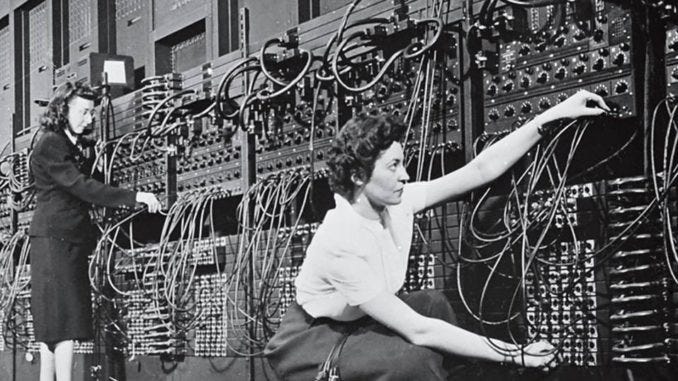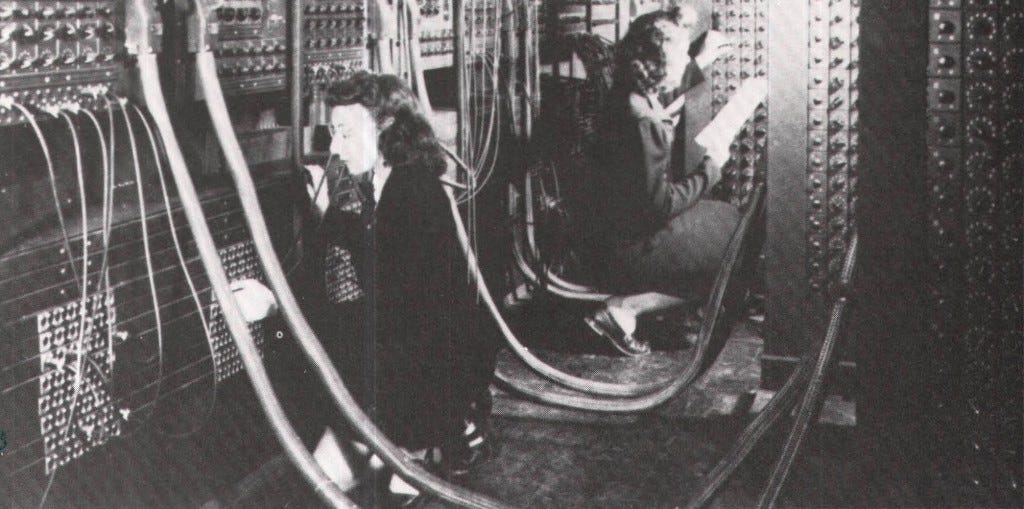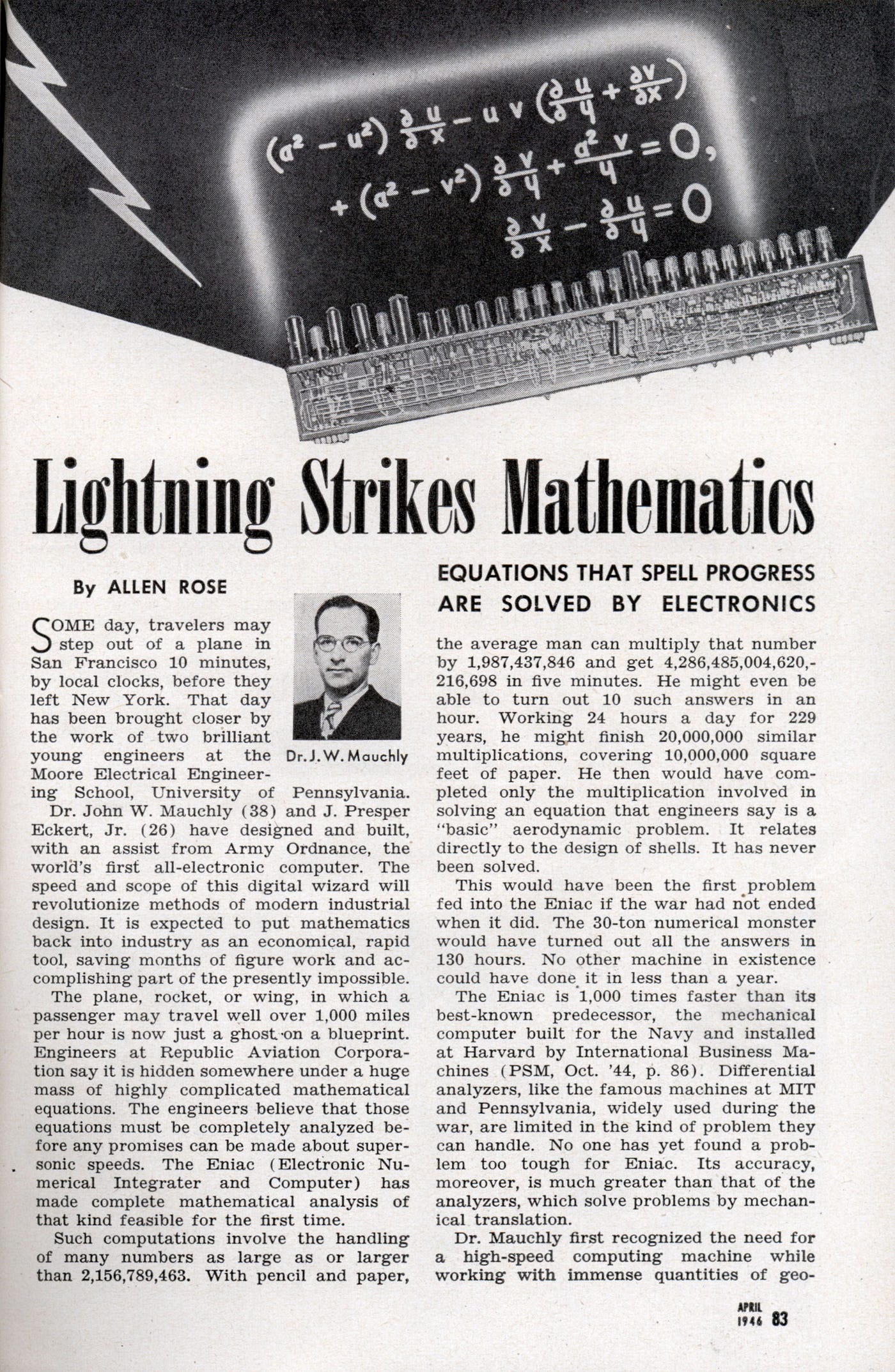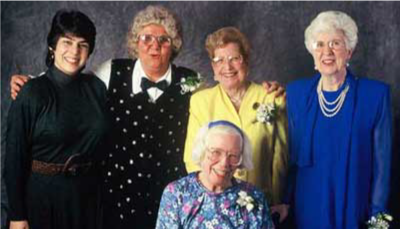Women in tech history: ENIAC and the programming pioneers that nobody knew
This is the third article in a series about amazing women in tech history. The first featured Margaret Hamilton, the programming pioneer who helped land us on the moon. The second featured Grace Hopper, the programming pioneer who became the first woman to be a US Navy Admiral.
In 1946, after World War II had ended, the US Army finally unveiled a top secret project to the public: ENIAC, the first general purpose, all-electronic computer. It was a game-changer. The press called it the “Giant Brain” and dreamed up fantastical futures where we all could have electronic computers in our lives. The designers, John Mauchly and John Presper Eckert, were celebrated for their achievement and rightly so; it was a marvel of engineering. It was designed to calculate ballistics for artillery but was also involved in calculations for the first hydrogen bombs.

Photo: University of Pennsylvania
In the 1980s, 40 years after the top secret computer was made public, a programmer named Kathy Kleiman asked a fascinating question: who are the women in nearly every photo of the ENIAC computer? They look busy. They’re changing cables and turning switches. What was their involvement in the project? The photos were taken at the public unveiling but the women there weren’t actually introduced. The world had no idea who they were, which is a shame because they were the first programmers of the all-electronic computer.
Ballistics

During World War II, long range canons struggled to hit targets that were miles away because the weather affected the trajectory of the missile fired. Using complex equations, which could be modified for different environmental conditions, the accuracy of weapons could be improved. Gunners would look at “firing tables”, which told them where to aim to get the range they were looking for given a specific condition.
The horrifically complex equations were a nightmare. For every possible range of every weapon, they needed to calculate different angles that took everything else into account including temperature and humidity. The equations were so difficult that it took experts days to calculate a single trajectory. This clearly wasn’t something that gunners could calculate on the spot. Instead, the firing tables would need to be calculated by huge teams in order to keep up with the demand.
The problem was that most men with mathematics degrees were fighting overseas or involved in other areas of research such as Project Manhattan. In 1942, the US Army decided to turn to women and put out ads in newspapers looking for maths graduates to work on these calculations at the University of Pennsylvania.
Human “computors”
Betty Holberton was a keen student with a passion for mathematics when she arrived at the University of Pennsylvania to begin a maths degree. On the very first day, her maths professor suggested that her time would be better spent at home raising children. She decided to study journalism instead, since it would allow her to travel, but soon came back to maths when she was hired by the university’s Moore School of Engineering as a “computor”: literally a person that does computations.
Over 100 women were brought in to do the computations necessary for long range weapons to be fired effectively in the war. They each worked with just a pen, paper, and a calculator. It took around 40 hours to do a single trajectory; some of the more difficult ones took a week. The women worked well but simply couldn’t keep up with the machinery of war. The Army needed firing tables faster than the women could calculate them and some guns sat unused. Human computers were too slow.
ENIAC
Funded by the US Army and built by Moore’s School of Engineering, a top-secret computer was built codenamed “Project PX” but would later come to be called ENIAC (Electronic Numerical Integrator And Computer). It was an experimental long shot but it was hoped that the first general purpose, all-electronic computer could drastically improve the speed of trajectory calculations for the firing tables.
The women working on the calculations by hand had no idea about the project. The computer cost $500,000 at a time when the women were making $2000 a year. It worked, it was an engineering marvel, but it couldn’t do anything useful by itself. It was all hardware back then and had to be told what to do. It might be hard to imagine how primitive this computer was but realise that we’re not even talking about punching holes into cards here. Making the computer do something involved using 3,000 switches, 18,000 vacuum tubes, and hundreds of cables. It was 100 ft long and stood 8 ft tall. Different units could do different functions and store a 10-digit number to be passed to the next unit. It seems very alien compared to what we have today.
What ENIAC needed were programmers. They needed to be maths experts who knew the trajectory calculations but they also needed to know how to program the ENIAC. Unfortunately, nobody really knew how to program it. Whoever started would be the first. Of the 100 or so women currently “computing” by hand, 6 were chosen to work on ENIAC. They were Jean Bartik, Kathleen Antonelli, Marlyn Meltzer, Frances Spense, Ruth Teitelbaum, and Betty Holberton who had been told to stay at home to raise children.
Programmers
The challenge that the ENIAC women faced cannot be overstated. Absurdly, they weren’t allowed to see the computer since it was still top secret. Instead, they were given the circuit diagrams and blueprints for the machine and told to teach themselves how it worked. They had to figure out how to program the first general purpose electronic computer purely by studying the inner workings of the machine. Think about how challenging this would have been the next time you struggle with IKEA instructions.
“They had no books or anything to teach us how to program it.” — Jean Bartik

Photo: University of Pennsylvania
Our modern computers do the hard work and we just tell them what to do. Modern computers didn’t appear overnight but gradually evolved so there was a transition between people doing all the computations and computers doing them. The ENIAC was an intermediate, almost like a biological computer with the women as components in the system. The ENIAC couldn’t store software. Instead, the women and the computer worked together as one. The women did the calculations, determined how to have the ENIAC compute the given problems, and then programmed the 1000 kg machine by moving cables around and turning the 3000 different dials. The women said it was difficult, that it was a nightmare at times, and that they loved every moment of it.

Photo: University of Pennsylvania
They did it. The programmers got the computer calculating a month’s worth of trajectories in a day. They even performed calculations for the feasibility of thermonuclear bombs. Eventually the war was over but it wasn’t the end for the ENIAC. It was developed further to become a “stored program” computer, more closely resembling the modern computers we use today. Jean Bartik led the team that developed the new capabilities.
Going public
In 1946, the US Army dropped the project’s top secret classification and unveiled the ENIAC to the public. It was a big deal and several events were held including a press event where most of the photos we see today were taken. The women were there because the press were given a working demonstration to show how quickly it made advanced calculations. People were truly amazed and the “Giant Brain” made front page headlines of several newspapers.

The ENIAC women had two roles: to demonstrate the machine in action and to pose for photos. They became models for the day. “I wasn’t photogenic and I wasn’t included in any of the pictures of the entire stupid thing,” said Betty Holberton. The others were asked to pose for photos, which was fun and it was good to be receiving some recognition for their work. Unfortunately, they weren’t introduced to the press. Their names weren’t recorded and their work wasn’t stated. The designers were celebrated but not the programmers.
After that press event there was another for the science and military community. According to Holberton, the ENIAC women once again weren’t introduced or celebrated. “None of us were introduced; we were just the programmers.” Everyone, including the scientists and military officials, went for dinner but the women weren’t invited. They were the first programmers of a general purpose, all-electronic computer and nobody knew their names.
Recognition
The ENIAC women had great careers and lived fascinating lives. Take Betty Holberton for example: she should have been at home raising children but instead created the first instruction code, invented the first sort routine (yes, when you sort things into order on your computer), and created the first software package. By 1959 she was the Chief of the Programming Research Branch in the Applied Mathematics Laboratory at the David Taylor Model Basin. She even went on to work with Grace Hopper on the COBOL programming language and invented the numeric keyboard (thank you).
Despite their achievements, the ENIAC women were largely unknown for 40 years. It wasn’t just that the general public didn’t know them; tech historians didn’t know they existed. It wasn’t until the 1980s when they were rediscovered by programmers and historians such as Kathy Kleiman. In 1997, after all those years without recognition, the ENIAC women were inducted into the Women in Technology International Hall of Fame.

Kathy Kleiman, who rediscovered the ENIAC programmers, standing to the left of Jean Bartik, Marlyn Meltzer and Kay Antonelli. Betty Holberton is in front. Photo: ENIAC Programmers Project
They made strides for women in their later years, working to promote computing to young women and inspiring them with their stories. Imagine being told you can’t do maths and then working on thermonuclear bombs? Imagine being told your education will be a waste of time but end up creating the first user-friendly programming languages?
Their stories show how women can be tech pioneers but they also highlight the sexism that exists in the industry. The ENIAC women should be role models for programmers or anyone who wants to push boundaries and develop next generation technologies. And if you’re thinking about creating a tech startup, look no further than the ENIAC women for inspiration:
“I was told I’d never make VP rank because I was too outspoken. Maybe so, but I think men will always find an excuse for keeping women in their ‘place’. So, let’s make that place the executive suite and start more of our own companies.” — Jean Bartik
You can learn more about the ENIAC programmers at the website for the ENIAC Programmers Project.
This is the third article in a series about amazing women in tech history. The first featured Margaret Hamilton, the programming pioneer who helped land us on the moon. The second featured Grace Hopper, the programming pioneer who became the first woman to be a US Navy Admiral. The next is about Katherine Johnson, who calculated the trajectories that landed humans on the moon.